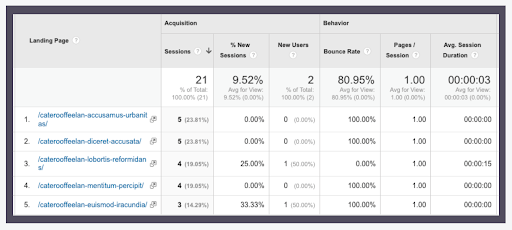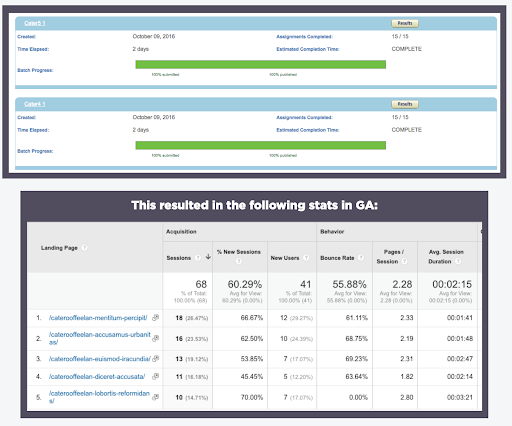This test is a follow up test to see whether adding an event in Google Tag Manager to reduce bounce rates will result in movement in the SERPs. We successfully added an event to Google Tag Manager and reduced bounce rates from 100% to 0%, but will this be able to affect rank?
Test Setup
Five pages were set up for this test. We set up a timer in Google Tag Manager to only fire for page views on the third ranking page.
We fired up BrowSEO and visited each page, scrolling down the page for 30 seconds, and then clicking the back button on the browser. Our expectation is that GA will show 0% bounce rate for the page we have added the timer to and 100% for the rest of the pages. This is confirmed in the below image:

Because most of the BrowSEO visits were not considered new users, we set-up 5 batches in Mechanical Turk that was meant to send 15 visitors to each page who would spend at least 30 seconds on the page.

The above didn’t result in any movement in the SERPs and so we asked members of the SIA Facebook group to visit one of the 5 pages and stay on the page for at least 30 seconds.


Results
Unfortunately, the test results are inconclusive. Perhaps we need to send more traffic to see if a definite trend emerges or perhaps the SERPs are currently in limbo and will settle showing a conclusive result. Sending traffic to a page and getting the user to do what you want is very difficult – what we were trying to achieve for the experiment page is to have zero bounce rate with 15 second time on site, and all other pages to have 100% bounce with zero time on site. Unfortunately, the stats are not showing that this has occurred. We will continue to monitor the SERPs to see if a definite trend emerges.
Clint’s Feedback
In this video, Clint talks about this test.
This is test number 71, it’s part two of our bounce rate hack test that we want to see if it helps, see if it’s working.
Alright, so if you’re not aware of part one, essentially what we’re doing is using Google Tag Manager to manipulate the bounce rate of a web page and the idea is that, somehow Google is monitoring your bounce rate or the bounce rate of every website on the internet and it’s using that as a user experience algorithm piece to help determine ranking. And thus, if you have, let’s say, you have a high bounce rate, your page is going to 100% in Google Analytics, you think that’s bad. So you’re going to use Google Tag Manager and you fire off an event inside of Google Tag Manager, and that lowers the bounce rate.
And in order to understand why that is, there’s it’s a couple things. So if your bounce rate is 100%, let’s say you write this article, it’s 100%, is ranking on Google and your bounce rate is 100%. That is telling you according to the way Google Analytics works, by default, that the visitor went to your page and they didn’t click anything else leading anywhere on your website. This might necessarily actually not even be a bad thing, so if you have a high bounce rate on a landing page, for example, let’s say you have a list building your landing page, you’re sending everyone to that to get them to sign up to your list in order to be forwarded to a product offer service. And that product offer service may not necessarily be on your same website, ergo, your bounce rate for your landing page is going to be 100%. That’s good. That’s what you want, you don’t want lower than that you don’t want 80s and 90s, because it means that you have copyright issues. Alright, so you know, they’re going to your landing page, and they’re clicking around on your website, and they’re not converting. So that’s why in a landing page, a high bounce rate is actually good, lower bounce rate means bad.
This argument is if you have lower bounce rates, you are going to rank better. Now, it’s kind of a flawed test and it’s really just because we don’t necessarily control how people navigate our website or interact with our website when we get there. Sure, we can set up an eye catches, like uses of headlines, uses of imagery and stuff, we could get him to scroll the read the next paragraph, right? We can get them to do that. But at the end of the day, it’s the user. And so this test is kind of combining bounce rate with ping back. And the difference is, ping back, you go to the search results, you click on a link, it’s not what you want, you click back and you go back, and you’re ping ponging I think is the term that some retard made up. I’m not even sure but ping ponging is the other one. So you go to the SERPs, go to a page, and go back. And that is inevitably tested in here too plus, there’s some movement on the pages and stuff like that.
At the end of the day, it had zero effect on the test page, here. So the bounce rate could be 100%, bounce rate could be zero, nothing showed any improvement or otherwise.
So you could come to that conclusion because nothing showed that Google is not necessarily using bounce rate, they may be using ping back. But that’s a little bit harder to see. But for sure, you can you can come to the possible conclusion that they’re not using bounce rate. But in this case, this is one of those tests where you call it inconclusive because you just don’t know. We just can’t know because there’s too many other variables. Again, we talked about how a user use your page, how long they’re on your page, how long they click around your page, how long do they take to read, look at all the images, all that stuff. All those things are in here and kind of muddle this test up. And so the test results are inconclusive. But I also think that because they are inconclusive, we could probably reasonably expect that bounce rate is not really a ranking factor. It is a good CRO measurement, though, so you don’t want to discount this metric. But it’s not necessarily a factor.
I hope you appreciate this one. I know it’s kind of a lot impacted into a little test here. But that’s what makes testing exciting.
